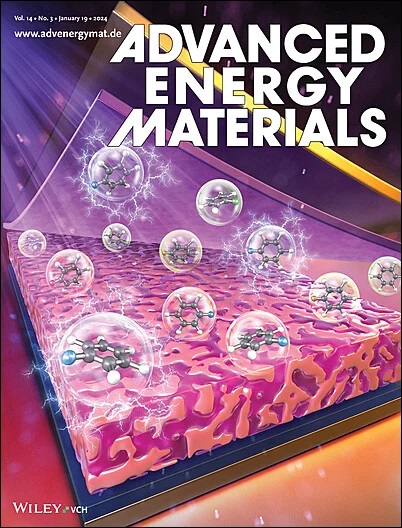Doped‐NiOx Seed Layer on Textured Substrates for Low‐Loss Contacts in Perovskite Solar Cells
IF 24.4
1区 材料科学
Q1 CHEMISTRY, PHYSICAL
引用次数: 0
Abstract
Further improvements in photocurrent are essential to unlock higher efficiencies in inverted (p‐i‐n) perovskite solar cells (PSCs). While the use of textured substrates has proven successful in normal structure (n‐i‐p) devices to improve photocurrent, applying the same approach to p‐i‐n architecture is challenging due to difficulties in depositing ultra‐thin self‐assembled monolayers (SAMs) on uneven surfaces. To overcome this limitation, a rubidium‐based ammonia treatment for nickel oxide seed layers is proposed. This strategy enhances the surface homogeneity of hole‐transporting layers on textured substrates, facilitates perovskite defect passivation, and improves SAM anchoring, collectively enhancing hole extraction and suppressing non‐radiative recombination. As a result, the optimized PSCs achieves a champion power conversion efficiency (PCE) of 25.66% with a fill factor of 86.35% and demonstrates excellent long‐term stability, retaining 95% of their initial PCE after 1,000 hours following ISOS‐L‐2I protocol. Moreover, the scalability of this approach is validated with a 1 cm求助全文
约1分钟内获得全文
求助全文
来源期刊

Advanced Energy Materials
CHEMISTRY, PHYSICAL-ENERGY & FUELS
CiteScore
41.90
自引率
4.00%
发文量
889
审稿时长
1.4 months
期刊介绍:
Established in 2011, Advanced Energy Materials is an international, interdisciplinary, English-language journal that focuses on materials used in energy harvesting, conversion, and storage. It is regarded as a top-quality journal alongside Advanced Materials, Advanced Functional Materials, and Small.
With a 2022 Impact Factor of 27.8, Advanced Energy Materials is considered a prime source for the best energy-related research. The journal covers a wide range of topics in energy-related research, including organic and inorganic photovoltaics, batteries and supercapacitors, fuel cells, hydrogen generation and storage, thermoelectrics, water splitting and photocatalysis, solar fuels and thermosolar power, magnetocalorics, and piezoelectronics.
The readership of Advanced Energy Materials includes materials scientists, chemists, physicists, and engineers in both academia and industry. The journal is indexed in various databases and collections, such as Advanced Technologies & Aerospace Database, FIZ Karlsruhe, INSPEC (IET), Science Citation Index Expanded, Technology Collection, and Web of Science, among others.
 求助内容:
求助内容: 应助结果提醒方式:
应助结果提醒方式:


